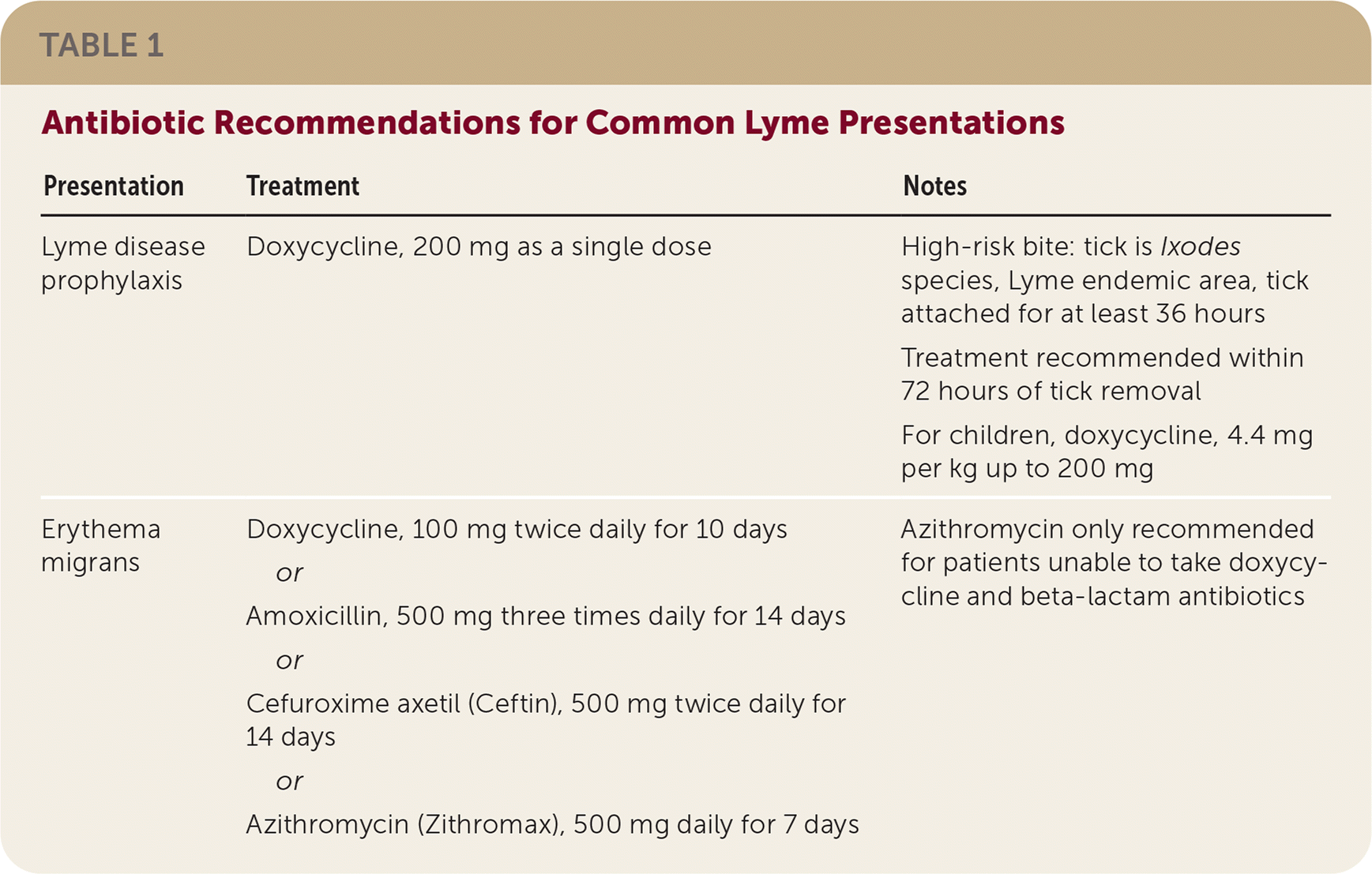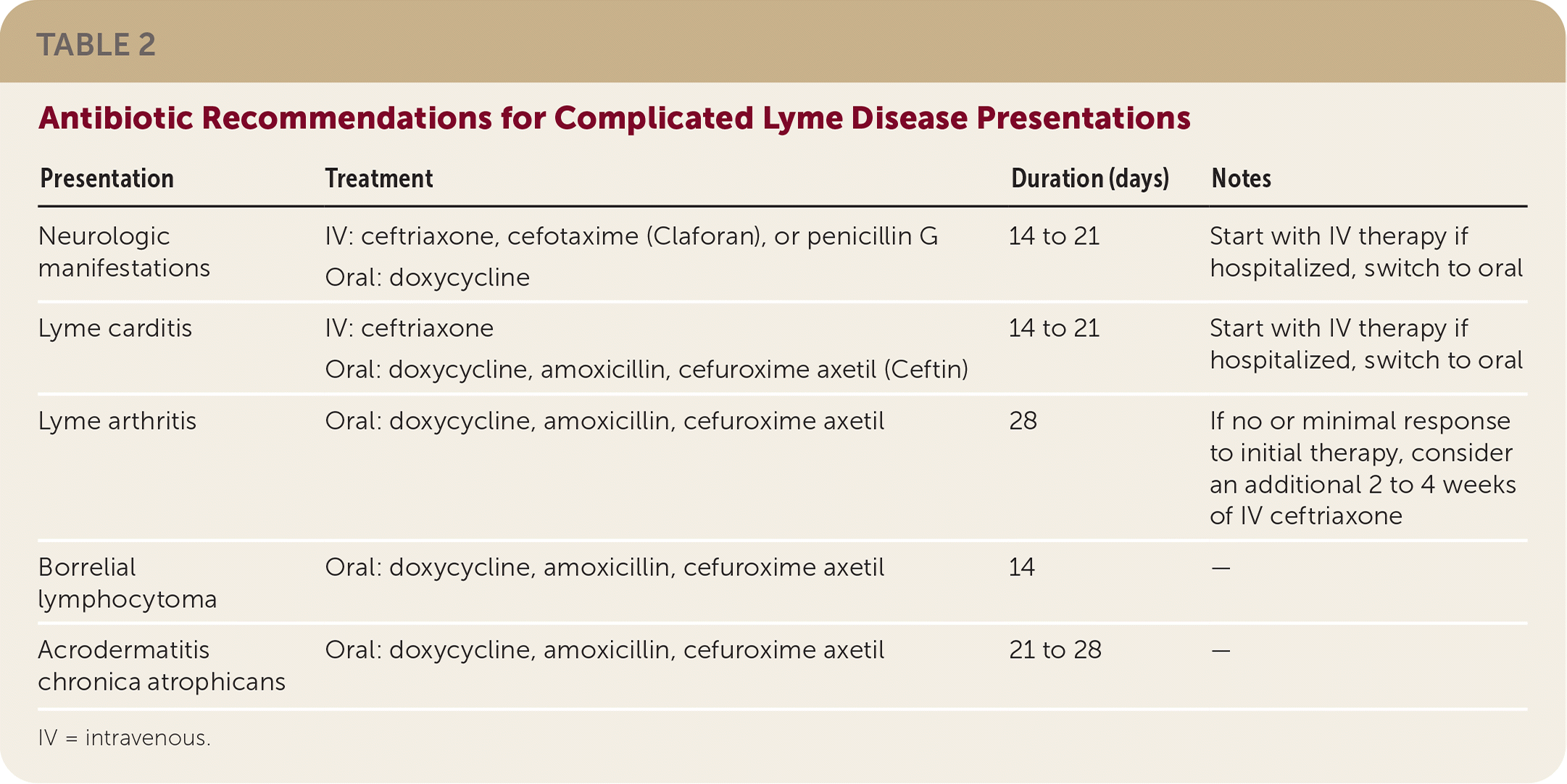
Am Fam Physician. 2021;104(6):652-654
Author disclosure: No relevant financial affiliations.
Key Points for Practice
• Prophylaxis for Lyme disease is most beneficial for high-risk bites, which include those from an Ixodes tick in an endemic area that was attached for at least 36 hours.
• Antibiotic treatment is recommended for classic erythema migrans or a possible Lyme presentation with positive serum antibody testing.
• Routine testing for Lyme disease is not beneficial in psychiatric disorders, behavior disorders, or chronic cardiomyopathy.
From the AFP Editors
Lyme disease, a tick-borne spirochete infection caused by Borrelia burgdorferi, is most common in three regions in the United States—the northeastern states from Virginia to Maine; the upper Midwest, especially Wisconsin and Minnesota; and northern California. A multidisciplinary panel representing the Infectious Diseases Society of America (IDSA), the American Academy of Neurology (AAN), and the American College of Rheumatology (ACR) has published recommendations on the prevention, diagnosis, and treatment of Lyme disease.
Prevention of Lyme Disease
The key to preventing Lyme disease is to avoid tick bites and prolonged tick attachment. Basic protection measures include avoiding risky areas, wearing long sleeves and pants, tucking pants into socks, and using clothing treated with permethrin. Unlike permethrin, many effective repellants are safe to apply to skin including N,N-diethyl- m-toluamide (DEET), picaridin, ethyl-3-(N-n-butyl-N-acetal) aminopropionate (IR3535), oil of lemon eucalyptus, p-methane-3,8-diol (PMD), and 2-undecanone.
Because spirochete transmission occurs after at least 36 hours of attachment, ticks should be removed promptly after discovery. After exposure to a tick habitat, thorough tick checks of exposed and intertriginous skin, bathing within two hours, and drying clothes for at least one hour on high heat can prevent disease. Ticks can be removed with tweezers and placed in a bag for later identification. To remove ticks, fine-tipped tweezers should be used to grasp the mouth parts as close to the skin as possible and steady traction applied directly away from the skin. Because B. burgdorferi in ticks does not predict infection in humans, testing ticks is not recommended.
High-risk tick bites include those from an Ixodes tick in an endemic area that was attached for 36 hours or more. When all high-risk criteria are met, prophylactic treatment in adults and children with a single dose of doxycycline within 72 hours of tick removal (Table 1) is recommended. Without all high-risk features, monitoring for symptoms is as effective as treatment. Serologic testing following tick exposure in a patient with no symptoms is not helpful.

| Presentation | Treatment | Notes |
|---|---|---|
| Lyme disease prophylaxis | Doxycycline, 200 mg as a single dose | High-risk bite: tick is Ixodes species, Lyme endemic area, tick attached for at least 36 hours Treatment recommended within 72 hours of tick removal For children, doxycycline, 4.4 mg per kg up to 200 mg |
| Erythema migrans | Doxycycline, 100 mg twice daily for 10 days or Amoxicillin, 500 mg three times daily for 14 days or Cefuroxime axetil (Ceftin), 500 mg twice daily for 14 days or Azithromycin (Zithromax), 500 mg daily for 7 days | Azithromycin only recommended for patients unable to take doxycycline and beta-lactam antibiotics |
Erythema Migrans
For skin lesions that are typical for erythema migrans, empiric treatment for Lyme disease is recommended. The primary treatment is doxycycline, 100 mg twice daily for 10 days in adults, or one of several alternate regimens (Table 1). Testing is not helpful with typical erythema migrans.
For skin lesions that are atypical for erythema migrans, serum antibody testing is recommended with follow-up convalescent phase testing for negative results. Serology is the most accurate testing method for Lyme disease, despite false negatives that can occur with acute illness. Antibody testing is universally recommended over polymerase chain reaction testing or culture. Antibodies remain elevated after infection, making diagnosis of repeat infections challenging.
If a patient has a high-grade fever for more than one day while receiving antibiotics for Lyme disease, testing for coinfection with Anaplasma phagocytophilum and Babesia microti should be considered. Both illnesses can present with leukopenia, neutropenia, or anemia that is uncommon in Lyme disease. Babesiosis can also present with indirect bilirubinemia and elevated lactate dehydrogenase.
An erythema migrans–like rash can also be seen following the bite of a Lone Star tick (Amblyomma americanum), causing southern tick–associated rash illness (STARI). It is unknown whether antibiotics are effective in STARI, but STARI and Lyme disease can overlap geographically. Empiric antibiotics are recommended in those areas when the two conditions cannot be distinguished.
Neurologic Manifestations of Lyme Disease
Lyme disease can cause peripheral manifestations including cranial neuritis, radiculopathies, and neuropathies. Central nervous system manifestations include meningitis, increased intracranial pressure, and encephalitis. Lyme disease is not associated with seizures, amyotrophic lateral sclerosis, multiple sclerosis, dementia, or Parkinson disease.
Most patients with Lyme neuroborreliosis have positive serum Lyme serology results but are unlikely to have Lyme disease detected by polymerase chain reaction testing or culture. Serology is the only routinely recommended Lyme-specific test. When testing cerebrospinal fluid for suspected Lyme neuroborreliosis, serum and cerebrospinal fluid antibody titers should be compared.
Psychiatric Illness or Behavioral Disorders
Routine testing for Lyme disease in psychiatric illness should be avoided. Similarly, Lyme disease screening is not helpful for developmental or behavioral disorders in children.
Suspected Lyme Carditis
In locations where Lyme disease is endemic, patients with pericarditis or myocarditis without an obvious source can benefit from Lyme antibody testing. In patients with chronic cardiomyopathy, testing for Lyme disease should be avoided.
For cardiac symptoms in patients with Lyme disease, electrocardiography should be performed. Common cardiac symptoms include dyspnea, edema, palpitations, lightheadedness, chest pain, or syncope.
In Lyme carditis, antibiotic courses last 14 to 21 days (Table 2). In the case of pericarditis, myocarditis, arrhythmias, or prolongation of PR intervals more than 300 milliseconds, inpatient admission should be considered. Symptomatic bradycardias can usually be managed medically or with temporary pacing. Permanent pacemakers are rarely required.

| Presentation | Treatment | Duration (days) | Notes |
|---|---|---|---|
| Neurologic manifestations | IV: ceftriaxone, cefotaxime (Claforan), or penicillin G | 14 to 21 | Start with IV therapy if hospitalized, switch to oral |
| Oral: doxycycline | |||
| Lyme carditis | IV: ceftriaxone | 14 to 21 | Start with IV therapy if hospitalized, switch to oral |
| Oral: doxycycline, amoxicillin, cefuroxime axetil (Ceftin) | |||
| Lyme arthritis | Oral: doxycycline, amoxicillin, cefuroxime axetil | 28 | If no or minimal response to initial therapy, consider an additional 2 to 4 weeks of IV ceftriaxone |
| Borrelial lymphocytoma | Oral: doxycycline, amoxicillin, cefuroxime axetil | 14 | — |
| Acrodermatitis chronica atrophicans | Oral: doxycycline, amoxicillin, cefuroxime axetil | 21 to 28 | — |
Suspected Lyme Arthritis
Lyme arthritis presents similarly to other forms of septic arthritis, although cell counts tend to be lower in Lyme arthritis. Fever is less common in adults with Lyme arthritis.
Serum antibody tests are invariably positive in Lyme arthritis, whereas direct detection of Borrelia in joint fluid is less common. Patients with Lyme seropositive test results can be treated empirically. If other diagnoses are suspected, polymerase chain reaction testing of joint fluid for Borrelia may be considered, but culture should be avoided.
In Lyme arthritis, a 28-day course of oral antibiotics is recommended. If minimal or no response, intravenous ceftriaxone for two to four additional weeks should be considered. Referral is recommended if there is no response to additional treatment.
The views expressed are those of the author and do not necessarily reflect the official policy or position of the Department of the Navy, Uniformed Services University of the Health Sciences, Department of Defense, or the U.S. government.
Editor's Note: This guideline updates 2006 recommendations for Lyme disease treatment, although the changes are minor. In contrast, guidelines from the International Lyme and Associated Diseases Society (ILADS) from 2014 (https://www.ilads.org/patient-care/ilads-treatment-guidelines/) differ significantly from these recommendations. ILADS does not recommend prophylactic treatment because of concerns for limited effectiveness and possible increased seronegative disease but recommends treatment for 20 days in these patients. ILADS also recommends longer antibiotic courses for erythema migrans.— Michael J. Arnold, MD, Contributing Editor
Guideline source: Infectious Diseases Society of America, American Academy of Neurology, American College of Rheumatology
Evidence rating system used? Yes
Systematic literature search described? Yes
Guideline developed by participants without relevant financial ties to industry? No
Recommendations based on patient-oriented outcomes? Yes
Published source: Clin Infect Dis. January 23, 2021;72(1):e1–e48
Endorsed by the AAFP, July 2020: https://www.aafp.org/family-physician/patient-care/clinical-recommendations/all-clinical-recommendations/lyme-disease.html
